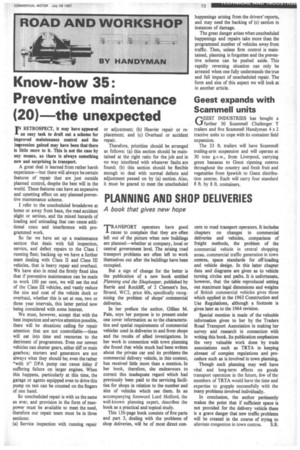Know-how 35: Preventive maintenance (20) the unexpected
Page 75

If you've noticed an error in this article please click here to report it so we can fix it.
'IN RETROSPECT, it may have appeared Aan easy task to draft out a scheme for improved maintenance control and the impression gained may have been that there is little more to it. This is not the case by any means, as there is always something new and surprising in transport.
A great deal is learned from rather harsh, experience—but there will always be certain features of repair that are just outside planned control, despite the best will in the world. These features can have an expensive and upsetting effect on any planned preventive maintenance scheme.
I refer to the unscheduled breakdown at home or away from base, the road accident slight or serious, and the mixed hazards of loading and unloading that can cause additional costs and interference with programmed work.
So far we have set up a maintenance section that deals with full inspection, service, and defect repairs to the Class I running fleet; backing up we have a further team dealing with Class II and Class III vehicles, that is heavy repair and overhaul. We have also in mind the firmly fixed idea that if preventive maintenance can be made to work 100 per cent, we will see the end of the Class HI vehicles, and vastly reduce the size and cost of the vehicle dock or overhaul, whether this is set at one, two or three year intervals, this latter period now being considered with some interest.
We must, however, accept that with the best inspection and service attention possible, there will be situations calling for repair attention that are not controllable—these will eat into time and resources to the detriment of programmes. Even our newest vehicles can shatter gears, either diff or main gearbox; starters and generators are not always what they should be; even the rather "with it" DPA pump can cause delay if suffering failure on larger engines. When this happens, particularly at this time, the garage or agents equipped even to drive this pump on test can be counted on the fingers of one hand.
So unscheduled repair is with us the same as ever, and provision in the form of manpower must be available to meet the need, therefore our repair team must be in three sections: (a) Service inspection with running repair or adjustment; (b) Heavier repair or replacement; and (c) Overhaul or accident repair.
Therefore, priorities should be arranged as follows: (a) this section should be maintained at the right ratio for the job and in no way interfered with whatever faults are found; (b) this section should be flexible enough to deal with normal defects and adjustment passed on by (a) section. Also, it must be geared to meet the unscheduled happenings arising from the drivers' reports, and may need the backing of (c) section in instances of damage.
The great danger arises when unscheduled happenings and repairs take more than the programmed number of vehicles away from traffic. Then, unless firm control is maintained, planning is forgotten and the preventive scheme can be pushed aside. This rapidly reversing situation can only be arrested when one fully understands the true and full impact of unscheduled repair. The form and size of this aspect we will look at in another article.




































































































































































